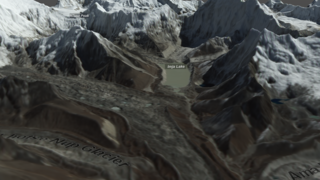Earth
ID: 13699
In the largest-ever study of glacial lakes, researchers using a 30-year satellite data record have found that the volume of these lakes worldwide has increased by about 50% since 1990 as glaciers melt and retreat due to climate change.
Glacial lakes are not stable because they are often dammed by ice or glacial sediment called a moraine, which is loose rock and debris that is pushed to the front and sides of glacier. Rather, they can burst their banks or dams, causing massive floods downstream. These kinds of floods from glacial lakes, also known as glacial lake outburst floods, have been responsible for thousands of deaths over the last century, as well as the destruction of villages, infrastructure and livestock.
Until now climate models that translated glacier melt into sea level change assumed that water from glacier melt is instantaneously transported to the oceans, which presented an incomplete picture. Therefore, understanding how much of glacial meltwater is stored in lakes or groundwater underscores the importance of studying and monitoring glacial lakes worldwide.
Tracking Three Decades of Dramatic Glacial Lake Growth
Glacial lakes are not stable because they are often dammed by ice or glacial sediment called a moraine, which is loose rock and debris that is pushed to the front and sides of glacier. Rather, they can burst their banks or dams, causing massive floods downstream. These kinds of floods from glacial lakes, also known as glacial lake outburst floods, have been responsible for thousands of deaths over the last century, as well as the destruction of villages, infrastructure and livestock.
Until now climate models that translated glacier melt into sea level change assumed that water from glacier melt is instantaneously transported to the oceans, which presented an incomplete picture. Therefore, understanding how much of glacial meltwater is stored in lakes or groundwater underscores the importance of studying and monitoring glacial lakes worldwide.
Source Material
Credits
Dan Shugar (University of Calgary): Lead Scientist
Umesh Haritashya (University of Dayton): Scientist
Jeffrey S. Kargel (Planetary Science Institute): Scientist
Katie Jepson (USRA): Lead Producer
Ellen T. Gray (ADNET Systems, Inc.): Lead Writer
Helen-Nicole Kostis (USRA): Lead Visualizer
Greg Shirah (NASA/GSFC): Lead Visualizer
Horace Mitchell (NASA/GSFC): Visualizer
Lucas Zurbuchen (GSFC Interns): Visualizer
Alex Kekesi (Global Science and Technology, Inc.): Visualizer
Erin Guiltenane (University of Calgary): Communications Advisor
Katie Jepson (USRA): Narrator
Umesh Haritashya (University of Dayton): Scientist
Jeffrey S. Kargel (Planetary Science Institute): Scientist
Katie Jepson (USRA): Lead Producer
Ellen T. Gray (ADNET Systems, Inc.): Lead Writer
Helen-Nicole Kostis (USRA): Lead Visualizer
Greg Shirah (NASA/GSFC): Lead Visualizer
Horace Mitchell (NASA/GSFC): Visualizer
Lucas Zurbuchen (GSFC Interns): Visualizer
Alex Kekesi (Global Science and Technology, Inc.): Visualizer
Erin Guiltenane (University of Calgary): Communications Advisor
Katie Jepson (USRA): Narrator
Please give credit for this item to:
NASA's Goddard Space Flight Center
NASA's Goddard Space Flight Center
Science Paper:
Shugar, DH, Burr, A, Haritashya, UK, Kargel, JS, Watson, CS, Kennedy, MC, Bevington, AR, Betts, RA, Harrison, S, Strattman, K. 2020. Rapid worldwide growth of glacial lakes since 1990. Nature Climate Change. https://doi.org/10.1038/s41558-020-0855-4
Short URL to share this page:
https://svs.gsfc.nasa.gov/13699
This item is part of this series:
Narrated Movies
Keywords:
DLESE >> Human geography
SVS >> Landsat
DLESE >> Natural hazards
GCMD >> Earth Science >> Cryosphere >> Glaciers/Ice Sheets
GCMD >> Earth Science >> Human Dimensions >> Natural Hazards
NASA Science >> Earth
GCMD >> Earth Science >> Climate Indicators >> Cryospheric Indicators >> Glacial Measurements
NASA Earth Science Focus Areas >> Climate Variability and Change
SVS >> Glacial Lakes
GCMD keywords can be found on the Internet with the following citation: Olsen, L.M., G. Major, K. Shein, J. Scialdone, S. Ritz, T. Stevens, M. Morahan, A. Aleman, R. Vogel, S. Leicester, H. Weir, M. Meaux, S. Grebas, C.Solomon, M. Holland, T. Northcutt, R. A. Restrepo, R. Bilodeau, 2013. NASA/Global Change Master Directory (GCMD) Earth Science Keywords. Version 8.0.0.0.0
Shugar, DH, Burr, A, Haritashya, UK, Kargel, JS, Watson, CS, Kennedy, MC, Bevington, AR, Betts, RA, Harrison, S, Strattman, K. 2020. Rapid worldwide growth of glacial lakes since 1990. Nature Climate Change. https://doi.org/10.1038/s41558-020-0855-4
Short URL to share this page:
https://svs.gsfc.nasa.gov/13699
This item is part of this series:
Narrated Movies
Keywords:
DLESE >> Human geography
SVS >> Landsat
DLESE >> Natural hazards
GCMD >> Earth Science >> Cryosphere >> Glaciers/Ice Sheets
GCMD >> Earth Science >> Human Dimensions >> Natural Hazards
NASA Science >> Earth
GCMD >> Earth Science >> Climate Indicators >> Cryospheric Indicators >> Glacial Measurements
NASA Earth Science Focus Areas >> Climate Variability and Change
SVS >> Glacial Lakes
GCMD keywords can be found on the Internet with the following citation: Olsen, L.M., G. Major, K. Shein, J. Scialdone, S. Ritz, T. Stevens, M. Morahan, A. Aleman, R. Vogel, S. Leicester, H. Weir, M. Meaux, S. Grebas, C.Solomon, M. Holland, T. Northcutt, R. A. Restrepo, R. Bilodeau, 2013. NASA/Global Change Master Directory (GCMD) Earth Science Keywords. Version 8.0.0.0.0












